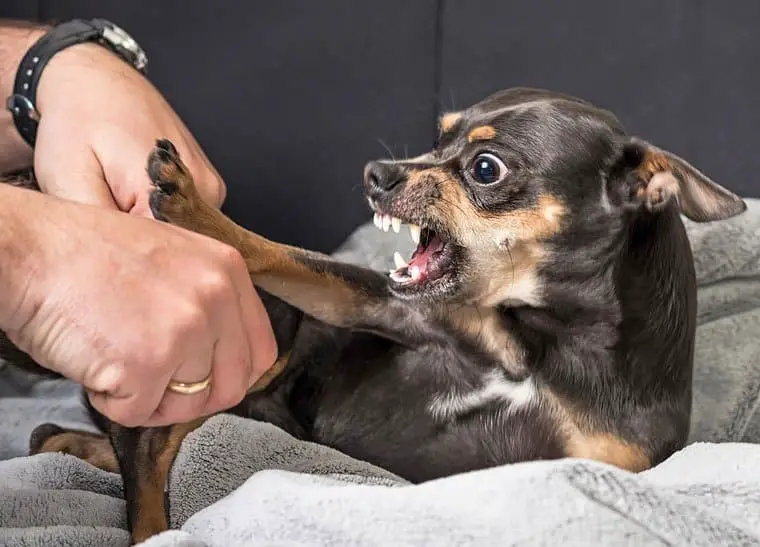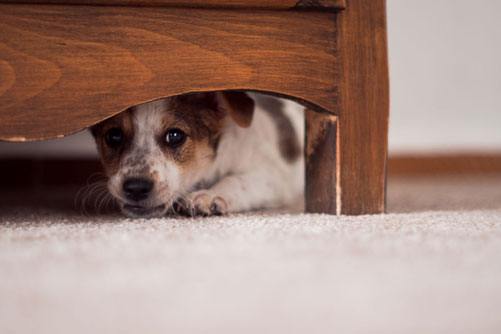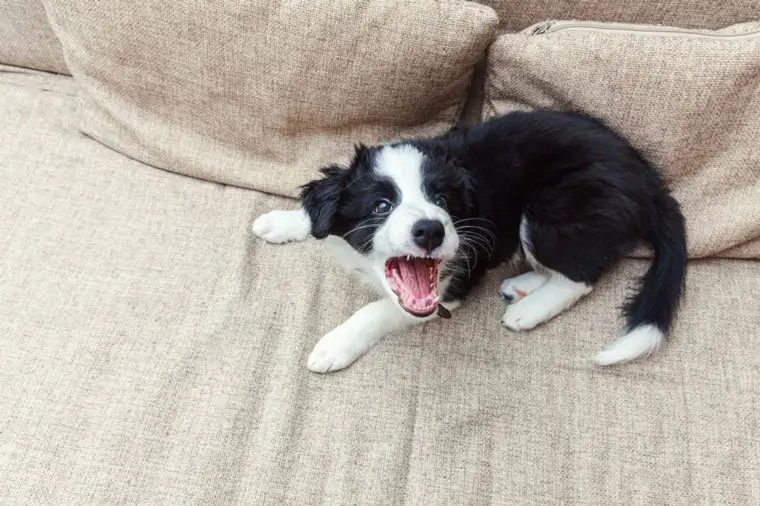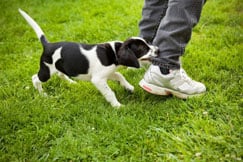Last Updated on 11/05/2020 by Veronica Jones

Raising a puppy is a lot of fun. There’s nothing like watching the first time your puppy experiences a new thing. It’s a lot of fun to train a puppy new behaviors. More generally, just watching a new puppy adjust to your life is great.
One thing that no puppy owner wants to worry about in their new puppy is aggression. Some puppies are prone to aggression because of genetics or lack of socialization. Some breeds may have protective or prey driven characteristics which may result in aggression.
Here are some aggressive puppy warning signs and what you can do if you see them.
Changing your perspective
It can be very hard to look at your adorable puppy and imagine the dog that they’re going to grow into. You really just want them to stay a cute puppy forever. Your puppy, on the other hand, is constantly trying to become a dog.
As your puppy begins to develop into the dog they’re going to be, it is essential that you shape behaviors that you want. Every behavior must be taken seriously. It may seem funny when you’re tiny, fluffy shepherd puppy barks or growls, but it won’t be nearly as funny when that happens when your dog is an adult.
Take your puppy seriously and be deliberate about shaping their behavior.
Puppy fear periods
Puppies go through two fear periods, during which they may be more likely to show fearful aggression. These fear periods can seem to come on quite suddenly and unexpectedly, so it is important to be aware of when they happen and be sure that you’re in control of your puppy during these times.

The first fear period is from 8 to 11 weeks, during which puppies are suddenly scared of people and animals and even objects that before had not concerned them. The second fear period is from 6 to 14 months.
This is often a frightening time for owners, as dogs that have excelled in training until 6 months suddenly show unexpected fear and refusal to obey commands. It may almost seem like your puppy is a different dog during this time. It is important to be patient, stay in control, and help your dog work through this challenging period.
Teaching your puppy proper behavior
Your puppy should already have shown the beginning signs of puppy aggression with their mother and littermates and learned something about when bites were too hard or when they just needed to leave their family alone.
You also need to teach your puppy what is inappropriate aggression and that biting you is not a good way to get your attention or get their way.
It is important to remember that puppies normally have a happy, naive response to the world. Puppies who growl, cower or snarl at novel but unthreatening stimuli in their environment, especially outside of fear periods, may be showing a predisposition towards aggression.
- Avoidance. If your puppy hides from new people or animals or is inappropriately fearful of objects it may progress into fear-related aggression as they get older.
- Active aggression. If your puppy lunges, barks in an alarmed manner, puts their hackles up, is stiff or shows other signs of aggression or fear in situations which should not be threatening such as meeting a friendly new person or animal, this is a clear sign that aggression is beginning.
- Excessive mouthing. It is normal for puppies to get to know their environment with their mouths, and this includes you. Puppies also seek out play by biting at your hands. However, if your puppy is biting and snapping at you when you’re handling them, it may show intolerance to being handled that will progress as they get older.
- Growling or protecting food or possessions. Puppies who growl or snarl when you take away their toys or food may develop more intense resource guarding so it is important to curb this behavior when they are young.
- Dominant play. Normal dogs switch roles as they play, with one sometimes having the upper hand and then the other. Puppies who insist on pinning other animals in play and don’t care about their signs of discomfort may develop into aggressive and dominant dogs.
Reasons for puppy aggression
Puppies may show aggression as a way of reacting to their environment and getting what they want from the world. They may also show aggression as a breed characteristic as they develop.
Some puppies are more prone to aggression because they are undersocialized or genetically prone to aggression. These are reasons for puppy aggression, warning signs related to them, and what you can do about it.
Understanding instincts
Dogs experience all kinds of different instincts as they develop. Depending on your dog’s breed, they may experience a strong drive to hunt, the need to protect, or the instinct to herd other animals and other instincts.
Some dogs have been bred to protect their owners, livestock, or even a vehicle. These protective instincts may come out unexpectedly, especially in the face of new triggers like meeting a new person. Here are some indications that a dog is acting aggressively out of instinct.
Barrier aggression

Many breeds were bred to think of barriers as a behavioral as well as a physical wall. Your puppy may react to a stranger or even a friend entering the house or yard with aggression. They may bark excessively, lunge, or raise their hackles.
It is essential to react to your puppy appropriately so that barrier aggression doesn’t escalate into aggression that continues as a guest enters the home. It is wise to work with a trainer when you see a puppy show barrier aggression, but a good rule of thumb is to call your puppy away from the barrier and have them go to their place, such as a crate, and give them a reward for coming and being quiet while you invite your guests into the home.
Your puppy will be able to watch as the guest settles in and you show friendship and therefore learn that it is not appropriate to be aggressive to this person. Your puppy should be happy to meet the new person after a few minutes.
Predatory aggression
Many dogs have been bred to hunt. The desire to hunt smaller animals may come out in just about any puppy. Some dogs may experience predatory aggression towards animals that they have otherwise grown-up with happily in the household.
To be safe, your puppy should never be left alone with smaller animals or children. If you do see your puppy stalking or playing too roughly with other pets, calmly redirect to an appropriate play item and make it clear what is a good subject of predatory play and what isn’t.
Social aggression
Some dogs are very confident and may try to assert what they want over other pets or even people in the household, even as young puppies. If your puppy is growling at you or starting fights with other dogs in the household, they may be displaying social aggression.
Bold, confident puppies need lots of structured activities and direction in order to positively develop their confident nature. Get your puppy involved in active obedience training, teach them a new canines sport, or do something else to give them direction.
If they show social aggression in your household, rely on their training to redirect their behavior. It is safest not to allow any puppy that shows aggression to be left alone with other pets or children.
 Keep in mind that in some cases, what appears to be social aggression is really herding behavior as your herding breed dog nips at the heels of people and other animals and tries to control their behavior. Such dogs should be given an outlet in herding activities.
Keep in mind that in some cases, what appears to be social aggression is really herding behavior as your herding breed dog nips at the heels of people and other animals and tries to control their behavior. Such dogs should be given an outlet in herding activities.
Aggression that you want
If you have chosen a breed that is historically a protector, like an Akita, Anatolian Shepherd, or Boxer, you are probably planning for some aggression in some circumstances. Raising a healthy and well-adjusted puppy is more about shaping when aggression is appropriate than entirely eliminating an aggressive response.
How to shape desired aggression in your puppy
If you want your puppy to protect your home or family, it is essential to work with a professional trainer to teach them how and when to behave aggressively. Unless you have worked with your dog with a sleeve and taught them to bite on command, you don’t know whether they will really follow through.
Allowing your dog to show aggressive behavior without training them what to do or how to follow-through can create an insecure, anxious dog who is more likely to act unpredictably. If you have chosen a dog breed who is brave enough to protect you and your family and has the instincts to do so, it is important to shape how you want those behaviors to play out.
Work with your trainer to practice scenarios in which you would want your dog to attack and work consistently on the ability to pull your dog back from an attack on command. It is important to shape your dog’s self-control so that they won’t attack without being told to do so or outside of the proper situation.
Remember that a dog who will display aggression and can back up that aggression with a powerful attack is a very dangerous animal akin to a loaded weapon. It is your responsibility to make sure that your dog never behaves inappropriately.
Aggression that you don’t want
You may have adopted a mixed breed dog, gotten a breed with a tendency towards aggression without realizing it, or have a dog that belongs to a breed without a tendency towards any kind of aggression who is showing aggressive traits.
In many ways, your response will be the same as towards aggression that you do want. You must provide outlets and direct aggressive instincts in order to control your dog.
What to do about a puppy that is showing unwanted aggression
If your puppy is showing signs of aggression that are worrisome or unwanted, it is important to train the proper behavior while they are young. Regardless of what your puppy is showing aggression towards, the steps are more or less the same. Remember to be patient. It takes time for a puppy to have the self-control for any training exercise, much less a training exercise that requires them to disregard a strong desire.
- Find a strong motivator. Does your puppy love peanut butter above all else? Do they have a favorite toy that they would do anything for? Whatever motivates your puppy the most, be sure that you have it available when you need to train.
- Be able to control your puppy. Equip your puppy with a well-fitted harness and sturdy bite-proof leash so that you will be able to control their movements as you progress with training. A sturdy crate can also be a very important training aid. In extreme circumstances, it may be necessary to muzzle train your puppy.
- Train your puppy just below their threshold. All dogs have a threshold below which they are able to show self-control and respond to training and beyond which they lost control. It is important to learn your puppy’s signals and slowly introduce stimulus that may prompt aggression so that you can train below your puppy’s threshold.
- Command and redirect. As soon as your dog begins to show aggression, perhaps when they see someone walking by the house or at the sight of a distant cat, give your dog a positive command like “sit” or “Look at me” and give them a reward. The goal is to increase your dog’s focus on you instead of on the object of aggression.
- Keep increasing the threshold. As your dog masters self-control at a low level of exposure to an aggression-prompting stimulus, you can increase their threshold while continuing to train self-control until your dog is able to control their aggression.
- Keep working. Once your puppy is no longer showing aggression, make sure that you keep exposing them to situations that previously caused aggression so that they not only control their aggression but completely overcome it.
In some circumstances, you may need to rehome your dog because of family circumstances. Here are a few instances when signs of a very aggressive puppy indicate that you should consider rehoming.
- Children in the home. If your dog has shown aggression towards people or if there are multiple pets in the home along with children and a dog has shown aggression towards the other dogs, it may be best to re-home. The consequences are severe if there is an accident between an aggressive dog and a child. It is much easier to rehome your puppy to a family without children when your dog is young, so it may be best to go ahead and rehome instead of taking a risk of your child being hurt. That said, it is entirely up to your family to decide whether to re-home a potentially aggressive dog or work with it in the home. If you do intend to work with an aggressive puppy in the home with children present it is highly advisable that you hire a certified animal behaviorist to help you.
- Fights between dogs. Minor instances of aggression between dogs can be worked through in most cases, but serious fights that have occurred multiple times are often an indication that it may not work out. This is especially true if a puppy is instigating serious fights with an older dog.
- Inability to control the dog. Sometimes people get a puppy without quite realizing how big and powerful it will be. If your 6-month-old puppy is just about pulling you over, and if they are already showing aggressive tendencies, it is probably best to rehome before the dog gets to its full size and is uncontrollable.
Puppies that are genetically prone to aggression or undersocialized
Puppies that are not properly socialized with people up until only 12 weeks of age may develop a permanent distrust of human beings and show apparent lack of domestication. While these puppies may be able to learn to love and tolerate their family members, they may always show fear and aggression towards strangers.
Puppies must be exposed to socialization with people from between six to eight weeks of age at the bare minimum in order to be properly socialized with people. If you don’t know your puppy’s background and they seem excessively fearful, especially to new people or new situations, they may be limited in how much they can recover.
There is a strong link between genetics and fearfulness. In one study, two separate lines of Pointer dogs were maintained for 20 years. One line was bred from the most fearful and the other the least fearful dogs.
Since the first generations, fearfulness and outgoing characteristics have successfully been bred into these lines. Nervous dogs begin to show fear-related behaviors between 3 and 9 months. They are more startled by loud noises, exposure to new humans, and other stimuli. Not all, but some dogs who are excessively fearful may show aggression.
